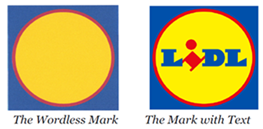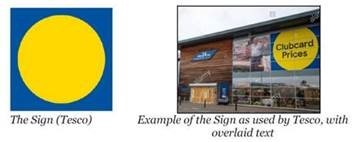John Coldham
Partner
Head of Brands and Designs (UK)
Co-leader of Retail & Leisure Sector (UK)
Article
13
The Court of Appeal of England and Wales (CoA) has confirmed that Tesco's Club Card Prices (CCP) marketing infringed Lidl's registered trademark (the 'Mark with Text') and amounted to passing off but did not constitute copyright infringement (overturning the High Court).
The CoA 's judgment illustrates well the dynamic patchwork of legal protection available under the UK's intellectual property regime, the balanced support provided for brands by the courts' application of that regime, and the need for caution and consideration by market players thinking of positioning their brand or its messaging more closely to their direct competitors. Circumstances that might mean one right does not assist a brand owner may yet enable protection pursuant to a different right.
Below, we explain the CoA 's reasoning, including its confirmation that another registration asserted by Lidl (for the 'Wordless Mark') was invalid, and why it overturned the High Court's finding that Tesco's CCP marketing amounted to copyright infringement too.
Lidl's registered trademarks were for the following devices:

Here is an example of use by Lidl:

Lidl complained about Tesco's use in its CCP marketing of signs comprising a yellow circle on a square/rectangular blue background:


Tesco's principal ground of appeal, against the High Court's findings of trade mark infringement and passing off, focused upon the finding (of fact) reached by the judge that the average consumer seeing Tesco's CCP signs would be led to believe that the prices being advertised had been price-matched by Tesco with the equivalent Lidl price i.e. to the same or a lower price.
As a finding of fact, the judge's conclusion on price matching could only be overturned if it was "rationally insupportable". In view of the evidence before the High Court, the CoA was satisfied that this finding was rationally supportable, even though at first sight it might seem surprising and even though the primary message of Tesco's CCP campaign was that Clubcard members would achieve better prices at Tesco than a consumer who had not joined the Clubcard scheme.
The evidence before the judge included evidence of an individual who had interpreted Tesco's CCP sign in TV adverts as conveying a price matching message, evidence of spontaneous, unprompted comments from members of the public who mentioned the blue and yellow features of Tesco's CCP signs, and evidence of a survey commissioned by Tesco prior to its decision to adopt the CCP signage. The judge was not only entitled to place some weight on each of these strands of evidence, but also to regard each of them as reinforcing the other two.
This meant that Tesco's appeal against the finding of passing off failed; and so did its appeal against the finding of trade mark infringement pursuant to section 10(3) of the Trade Marks Act 1994 by reason of 'unfair advantage' being taken of the distinctive character or repute of Lidl's Mark with Text.
The High Court had also found s.10(3) infringement by reason of 'detriment' to the 'distinctive character' of Lidl's Mark with Text. Interestingly, Tesco did not challenge the judge's finding that Tesco's use of the CCP signs diluted the distinctiveness of the Mark with Text, but contended that this was not sufficient for s.10(3) infringement absent a consequential change in the economic behaviour of consumers. However, Arnold LJ noted that the judge's finding of infringement on this basis drew on two further findings: that Tesco's CCP campaign had been successful in slowing the switching of consumers from Tesco to Lidl (and Aldi) that was otherwise occurring; and that Lidl had felt obliged to engage in corrective advertising promoting its lower prices compared to Clubcard prices. Therefore, a change in economic behaviour had in fact been made good on the evidence and so Tesco's appeal against this second finding of s.10(3) infringement failed too.
Unusually, the CoA was split as to the role of the 'due cause' element in the assessment of s.10(3) infringement. The point was not determinative in the appeal but suggests that higher court scrutiny may be warranted in another case. Arnold LJ indicated that consideration of 'due cause' arises where the proprietor of the registered mark has shown there is injury to it, the assessment then turning to whether there was due cause for the use complained of. Birss LJ and Lewison LJ expressed difficulty with the idea that there could be conduct which took advantage of a registered mark and was unfair but was nevertheless with due cause: with an eye on the wording of s.10(3) "if the use of the sign is with due cause, any resulting advantage is not unfair".
Tesco's pleaded case was that: i) Lidl had never used the Wordless Mark in the form in which it was registered; ii) it was to be inferred that Lidl had not intended to use the Wordless mark in the form registered; iii) if Lidl was right that use of the Mark with Text amounted to use of the Wordless Mark, it did not need to register the Wordless Mark unless the purpose was to give Lidl wider or different protection; and iv) it was to be inferred that the application to register the Wordless Mark was made solely for the purposes of using it as a legal weapon and not in accordance with its function of indicating origin.
Propositions i) and iii) were admitted by Lidl. Therefore in the absence of evidence to the contrary it was proper to make the inferences which were the subject of propositions ii) and iv). As a result, the pleaded case and the admitted facts gave rise to a prima facie case of bad faith, shifting the evidential burden to Lidl to explain its intentions when making its application in 1995.
Lidl's evidence was that, despite extensive investigations, Lidl had been unable to shed any light on its intentions when filing the applications to register the Wordless Mark; Lidl claimed privilege in respect of communications with its external trade mark attorneys. So there was no documentary evidence as to Lidl's intentions in 1995. Arnold LJ explained that since Lidl had chosen not to waive privilege, it could not be assumed that any such documents would have assisted Lidl, any more than it could be inferred that they would have supported Tesco. But this meant that Lidl had failed to meet the evidential burden upon it, and so Lidl's appeal against the High Court's finding that its Wordless Mark was invalid was dismissed.
The evidence in the case indicated a three-stage evolution by which Lidl's Mark with Text design was reached, spanning the 1970s and 1980s. The 'Stage 1' work was the stylised Lidl text. The 'Stage 2' work was a circular logo created in the form of a yellow circle with a red border, with the Lidl stylised text superimposed on it. The 'Stage 3' work created a square version of the logo in the form of a blue square with the yellow circular logo and stylised Lidl text superimposed, forming the Mark with Text.
The CoA agreed with Lidl and the High Court that the Stage 3 work resulting in the Mark with Text involved sufficient free and creative choice and was sufficiently original to warrant copyright protection.
However, the CoA disagreed with the High Court's finding of copyright infringement. Arnold LJ explained that copyright in an artistic work is only infringed if a "substantial part" of the work has been copied. In order to be "substantial", the part must contain an element of the work which, as such, expresses the author's own intellectual creation. Where there is sufficient creativity involved in the creation of the work for the work to be original, but the degree of creativity is low, the scope of protection conferred by the copyright in that work is correspondingly narrow, so that only a close copy will infringe. Tesco had not copied at least two of the elements which made the Stage 3 work original, namely the shade of blue and the distance between the circle and the square, and Lidl could not complain about the copying of the yellow circle itself, which was original to the Stage 2 work but not the Stage 3 work. Therefore, what had been copied was not sufficient to amount to infringement of Lidl's copyright in the Stage 3 work.
Lidl v Tesco dispute is one which relies heavily on the findings of fact. Another first instance judge might have reached a different conclusion, but that did not mean the first instance decision actually reached was wrong. Lewison LJ said he found himself in the position of Lord Bridge of Harwich in the Jif Lemon case:
"If I could find a way of avoiding this result, I would. But the difficulty is that the trial judge's findings of fact, however surprising they may seem, are not open to challenge. Given those findings, I am constrained ... to accept that the judge's conclusion cannot be faulted in law.
With undisguised reluctance I agree ... that the appeal should be dismissed."
The Lidl v Tesco judgments illustrate the flexibility presented by the UK's IP landscape, which comprises of a patchwork of different IP rights recognising different aspects of creativity and offering different scopes of protection. Circumstances that might mean one right does not assist a brand owner may yet enable protection pursuant to a different right.
In the circumstances of this dispute, trademark infringement was found on the basis of s.10(3), which provides a form of protection for marks with a reputation that (unlike s.10(2)) does not depend upon a likelihood of confusion being established i.e. as to the origin of the goods/services. The English common law tort of passing off – the predecessor to the UK's original registered trademark system – operated in Lidl's favour too. However the scope of copyright protection available to Lidl was limited by the iterative process by which its modern device evolved and so did not assist.
Had Lidl's device been created from scratch as a single work, the underlying facts as found by the judge would indicate that Lidl's claim for copyright infringement would most likely have succeeded; and so copyright could nevertheless have carried the day for Lidl before a first instance judge whose rationale settled against a finding of trade mark infringement and passing off.
Designs should also be remembered, in circumstances involving specific products. The registered designs regime permits broader protection for products developed in an iterative way (within 12 months prior to registration) than is available through copyright law; and two forms of unregistered design right enable protection both for the shape or configuration of a product and the appearance of a product (which may protect a 2D design), albeit for a shorter term than is conferred by a registered design or copyright law.
The CoA's judgment in the Lidl v Tesco case therefore illustrates well the dynamic patchwork of legal protection available under the UK's intellectual property regime, the balanced support provided for brands by the courts' application of that regime, and the need for caution and consideration by market players thinking of positioning their brand or its messaging more closely to their direct competitors.
The Court of Appeal's judgment in Lidl v Tesco [2024] EWCA Civ 262 (19 March 2024) is available here. Our article on the High Court's first instance decision can be found here.
NOT LEGAL ADVICE. Information made available on this website in any form is for information purposes only. It is not, and should not be taken as, legal advice. You should not rely on, or take or fail to take any action based upon this information. Never disregard professional legal advice or delay in seeking legal advice because of something you have read on this website. Gowling WLG professionals will be pleased to discuss resolutions to specific legal concerns you may have.